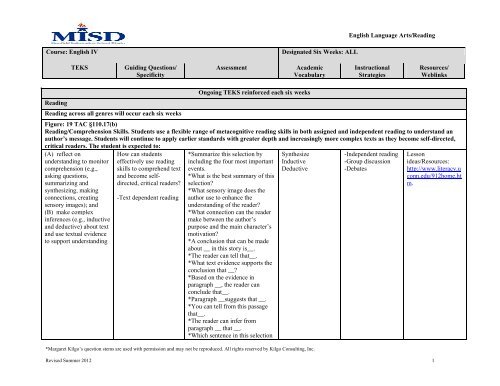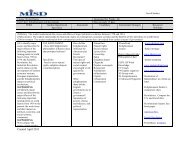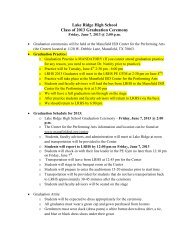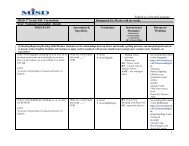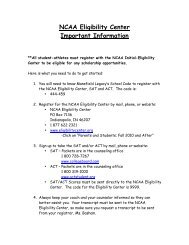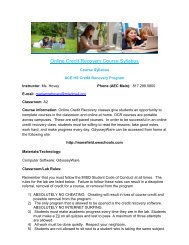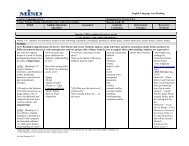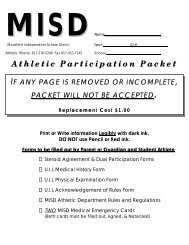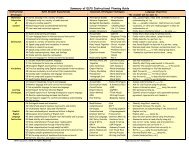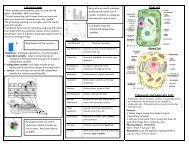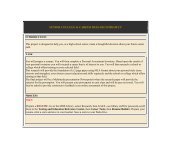Ongoing TEKS
Ongoing TEKS
Ongoing TEKS
You also want an ePaper? Increase the reach of your titles
YUMPU automatically turns print PDFs into web optimized ePapers that Google loves.
English Language Arts/ReadingCourse: English IVDesignated Six Weeks: ALL<strong>TEKS</strong>Guiding Questions/SpecificityAssessmentAcademicVocabularyInstructionalStrategiesResources/WeblinksReadingReading across all genres will occur each six weeks<strong>Ongoing</strong> <strong>TEKS</strong> reinforced each six weeksFigure: 19 TAC §110.17(b)Reading/Comprehension Skills. Students use a flexible range of metacognitive reading skills in both assigned and independent reading to understand anauthor’s message. Students will continue to apply earlier standards with greater depth and increasingly more complex texts as they become self-directed,critical readers. The student is expected to:(A) reflect onunderstanding to monitorcomprehension (e.g.,asking questions,summarizing andsynthesizing, makingconnections, creatingsensory images); and(B) make complexinferences (e.g., inductiveand deductive) about textand use textual evidenceto support understandingHow can studentseffectively use readingskills to comprehend textand become selfdirected,critical readers?-Text dependent reading*Summarize this selection byincluding the four most importantevents.*What is the best summary of thisselection?*What sensory image does theauthor use to enhance theunderstanding of the reader?*What connection can the readermake between the author’spurpose and the main character’smotivation?*A conclusion that can be madeabout __ in this story is__.*The reader can tell that__.*What text evidence supports theconclusion that __?*Based on the evidence inparagraph __, the reader canconclude that__.*Paragraph __suggests that __.*You can tell from this passagethat__.*The reader can infer fromparagraph __ that __.*Which sentence in this selectionSynthesizeInductiveDeductive*Margaret Kilgo’s question stems are used with permission and may not be reproduced. All rights reserved by Kilgo Consulting, Inc.-Independent reading-Group discussion-DebatesLessonideas/Resources:http://www.literacy.uconn.edu/912home.htm.Revised Summer 2012 1
English Language Arts/ReadingCourse: English IVDesignated Six Weeks: ALL<strong>TEKS</strong>Guiding Questions/SpecificityAssessmentAcademicVocabularyInstructionalStrategiesResources/Weblinkssupports the inference that __?*The reader can conclude that theauthor__.*What can you concludeabout__?*What information in this articlesupports the conclusion that __?*In paragraph__, the sentence “_-“ shows__.(12.1) Reading/Vocabulary Development: Students understand new vocabulary and use it when reading and writing. Students are expected to) (A) Determine themeaning of technicalacademic English wordsin multiple content areas(e.g. science,mathematics, socialstudies, the arts) derivedfrom Latin, Greek, orother linguistic roots andaffixes.(B) Analyze textualcontext (within a sentenceand in larger sections oftext) to draw conclusionsabout the nuance in wordmeanings;(C) Use the relationshipbetween wordsencountered in analogiesto determine theirmeaning (e.g.synonyms/antonym,connotation/denotation)(D) Analyze and explainAre students able toanalyze textual contextto determine wordmeaning?How will newvocabulary increasereading comprehensionand reasoningcapability?--SAT Vocabulary(coordinate withliterature)-Analogy instruction*In paragraph __of the story,what does the word __mean?*What is the root word for theword in paragraph __means__?*What words in paragraph__helpthe reader to conclude the impliedmeaning of the word__?*The word __in paragraph__means __because__.*In this story, the word _is inparagraph __: this word is to _as__is to __.*__is to __as __ is to__.*What does the expression _ asused in paragraph __mean?*The phrase __used in paragraph_means__.*The origin of the word __as usedin paragraph _ is_.*Read the dictionary entry for theword __. Which definitionrepresents the meaning of theword __ as used in paragraph _?(dictionary entry with fourSAT PREPVocabulary*Margaret Kilgo’s question stems are used with permission and may not be reproduced. All rights reserved by Kilgo Consulting, Inc.-Study vocabulary incontextELPS 4A, 4C, 4F,4K, 1H, 1BUse a variety ofcontent area booksActivities:http://www.webenglishteacher.com/vocab2.html.Revised Summer 2012 2
English Language Arts/ReadingCourse: English IVDesignated Six Weeks: ALL<strong>TEKS</strong>Guiding Questions/SpecificityAssessmentAcademicVocabularyInstructionalStrategiesResources/Weblinkshow the English languagehas developed and beeninfluenced by otherlanguages) (E) Use general andspecialized dictionaries,thesauri, histories oflanguage, books ofquotations, and otherrelated references (printedor electronic) as neededdefinitions is shown and studentsmust use context clues todetermine the meaning of theword as it is used in the passage.*Read the excerpt from a book ofquotations below and determinewhich quotation matches themeaning of the word __inparagraph as it isused in this selection.(12.2) Reading/Comprehension of Literary Text/Theme and Genre: Students analyze, make inferences and draw conclusions about theme and genre indifferent cultural, historical, and contemporary contexts and provide evidence from the text to support their understanding. Students are expected to:(A) Compare andcontrast works of literaturethat express a universaltheme(B) Compare andcontrast the similaritiesand differences in classicalplays with their modernday novel, play, or filmversion;(C) Relate the character,settings, and theme of aliterary work to thehistorical, social, andeconomic ideas of its time.-Theme-Students are exposedto a variety of genre*Of, relating to, extending to, oraffecting the entire the entireworld or all within the world;*Including, relating to, oraffecting all members of the classor group as the universalskepticism of all philosophers;*Applicable or common to allpurposes, conditions, or situationsas in a universal remedy.*What is a common theme foundI __ (excerpt from a classicalplay) and __ (excerpt from a filmversion)?*In comparing _ and _, what isthe difference in the moral lessonsin these two selections?*How is the theme of _ related toits historical setting?*What social trends of the time of*Margaret Kilgo’s question stems are used with permission and may not be reproduced. All rights reserved by Kilgo Consulting, Inc.Group discussionELPS 1C, 4K, 4Jhttp://www.studyguide.org/lit_approaches_high_school.htm.Revised Summer 2012 3
English Language Arts/ReadingCourse: English IVDesignated Six Weeks: ALL<strong>TEKS</strong>Guiding Questions/SpecificityAssessmentAcademicVocabularyInstructionalStrategiesResources/Weblinksthis story affected the characters’action?*In what way is the setting in thestory related to the economicideas of the time?(12.7) Reading/Comprehension of Literary Text/Sensory Language. Students understand, make inferences and draw conclusions about how an author'ssensory language creates imagery in literary text and provide evidence from text to support their understanding.Students are expected toanalyze how the author'spatterns of imagery,literary allusions, andconceits reveal theme, settone, and create meaningin metaphors, passages,and literary works.How does the authorcreate meaning in textusing sensorylanguage?-Text dependentreading*Which line from the story is anexample of a metaphor whichincreases the reader’sunderstanding of the theme?*The words “_” used by theauthor in paragraph _ mean_.Open-endedresponsesELPS 4J, 4K(12.8) Reading/Comprehension of Informational Text/Culture and History. Students analyze inferences and draw conclusions about the author’s purposein cultural, historical, and contemporary contexts and provide evidence from the text to support their understanding.Students are expected toanalyze the consistencyand clarity of theexpression of thecontrolling idea and theways in which theorganizational andrhetorical patterns of textsupport or confound theauthor’s meaning orpurpose.-Text dependentreading-Author’s purpose*What is the authors’ purpose inthe expression “__” inparagraph__?*The reader can tell that thecontrolling idea expressedthroughout this selection is __.*How does the author use theorganization of the ideas in thisselection to make his/her purposeconsistent?ELPS 4E, 4J, 4K(12.12) Reading/Media Literacy: Students use comprehension skills to analyze how words, images, graphics, and sounds work together in various forms toimpact meaning. Students are expected to:*Margaret Kilgo’s question stems are used with permission and may not be reproduced. All rights reserved by Kilgo Consulting, Inc.Revised Summer 2012 4
English Language Arts/ReadingCourse: English IVDesignated Six Weeks: ALL<strong>TEKS</strong>Guiding Questions/SpecificityAssessmentAcademicVocabularyInstructionalStrategiesResources/Weblinks(A) Evaluate howmessages presented inmedia reflect social andcultural views in waysdifferent from traditionaltexts;(B) Evaluate theinteraction of differenttechniques (e.g. layout,pictures, typeface in printmedia, images, text, soundin electronic journalism)used in multi-layeredmedia(C) Evaluate how oneissue or event isrepresented across variousmedia to understand thenotions of bias, audience,and purpose;(D) Evaluate changes informality and tone acrossvarious media for differentaudiences and purposes.Writing-Students view a varietyof media forms-Evaluate how audienceand message affectmediaRubric based on SE’s Group discussion andanalysisELPS 4K, 4D, 4F, 4IActivities:http://www.medialit.org/focus/tea_home.html.http://www.webenglishteacher.com/media.html.Safari Montage(12.13) Writing/Writing Process. Students use elements of the writing process (planning, drafting, revising, editing, and publishing) to compose text.Students are expected to:(D) Edit drafts forgrammar, mechanics, andspellingAre students able toedit proficiently?Students are held accountable forconventions on all writingassignments.Use exemplars formodelshttp://garbl.home.comcast.net/~garbl/writing/process.htm.Rubrics developed based on SEs*Margaret Kilgo’s question stems are used with permission and may not be reproduced. All rights reserved by Kilgo Consulting, Inc.ELPS 4J, 4K, 2F, 1GRevised Summer 2012 5Handbook:http://www.tc.umn.edu/~jewel001/gramma
English Language Arts/ReadingCourse: English IVDesignated Six Weeks: ALL<strong>TEKS</strong>Guiding Questions/SpecificityAssessmentAcademicVocabularyInstructionalStrategiesResources/WeblinksOral and Written Conventions(12.18) Oral and Written Conventions/Handwriting, Capitalization, and Punctuation. Students write legibly and use appropriate capitalization andpunctuation conventions in their compositions.Students are expected tocorrectly and consistentlyuse conventions ofpunctuation andcapitalization.Students are held accountable forconventions on all writingassignments.(12.19) Oral and Written Conventions/Spelling. Students spell correctly.Students are expected tospell correctly, includingusing various resources todetermine and checkcorrect spellings.Do students know howto access and utilize avariety of spellcheckers?Students are held accountable forcorrect spelling on all writingassignments.*Margaret Kilgo’s question stems are used with permission and may not be reproduced. All rights reserved by Kilgo Consulting, Inc.ELPS 5F, 5G, 1HELPS 5E, 5FRevised Summer 2012 6r/.Texas Write SourceResearch(12.21) Research/Gathering Sources. Students determine, locate, and explore the full range of relevant sources addressing a research question andsystematically record the information they gather. Students are expected to:(A) follow the researchplan to gather evidencefrom experts on the topicand texts written forinformed audiences in thefield, distinguishingbetween reliable andunreliable sources andavoiding over-reliance onone source;(B) systematicallyorganize relevant andaccurate information to-Determine researchquestion-Valid and reliablesources-Paraphrasing-Outlining-Note taking-Timelines for taskcompletionRubric based on SE’s -Teacher modeling-Critical readingELPS 2F, 2G, 4K, 4I,4J, 5B, 5GLibraryGale resourcesBig 6 ResearchModel:www.big6.com.
English Language Arts/ReadingCourse: English IVDesignated Six Weeks: ALL<strong>TEKS</strong>Guiding Questions/SpecificityAssessmentAcademicVocabularyInstructionalStrategiesResources/Weblinkssupport central ideas,concepts, and themes,outline ideas intoconceptualmaps/timelines, andseparate factual data fromcomplex inferences; and(C) paraphrase,summarize, quote, andaccurately cite allresearched informationaccording to a standardformat (e.g., author, title,page number),differentiating amongprimary, secondary, andother sources.(12.22) Research/Synthesizing Information. Students clarify research questions and evaluate and synthesize collected information. Students are expectedto:(A) modify the majorresearch question asnecessary to refocus theresearch plan;(B) differentiate betweentheories and the evidencethat supports them anddetermine whether theevidence found is weak orstrong and how thatevidence helps create acogent argument; and(C) critique the researchprocess at each step toimplement changes as theCan students clarify andmodify researchquestions to refocusresearch?-Evaluate evidenceRubric based on SE’s Teacher modeling*Margaret Kilgo’s question stems are used with permission and may not be reproduced. All rights reserved by Kilgo Consulting, Inc.ELPS 5G, 4KRevised Summer 2012 7LibraryGale resourcesBig 6 ResearchModel:www.big6.com.
English Language Arts/ReadingCourse: English IVDesignated Six Weeks: ALL<strong>TEKS</strong>Guiding Questions/SpecificityAssessmentAcademicVocabularyInstructionalStrategiesResources/Weblinksneed occurs and isidentified.(12.23) Research/Organizing and Presenting Ideas. Students organize and present their ideas and information according to the purpose of the researchand their audience. Students are expected to synthesize the research into an extended written or oral presentation that:(A) provides an analysisthat supports and developspersonal opinions, asopposed to simplyrestating exitinginformation;(B) uses a variety offormats and rhetoricalstrategies to argue for thethesis;(C) develops an argumentthat incorporates thecomplexities of anddiscrepancies ininformation from multiplesources and perspectiveswhile anticipating andrefuting counterarguments;(D) uses a style manual(e.g., Modern LanguageAssociation, ChicagoManual of Style) todocuments sources andformat written materials;and(E) is of sufficient lengthand complexity to addressthe topic.-Develop argument-Rhetorical devices-Documentation ofsourcesRubric based on SE’s Teacher modeling*Margaret Kilgo’s question stems are used with permission and may not be reproduced. All rights reserved by Kilgo Consulting, Inc.ELPS 5G, 5F, 4K, 1BRevised Summer 2012 8LibraryGale resourceswww.big6.com.Purdue OWL:http://owl.english.purdue.edu/.
English Language Arts/ReadingCourse: English IVDesignated Six Weeks: ALL<strong>TEKS</strong>Guiding Questions/SpecificityAssessmentAcademicVocabularyInstructionalStrategiesResources/WeblinksListening and Speaking(12.24) Listening and Speaking/Listening. Students will use comprehension skills to listen attentively to others in formal and informal settings. Studentswill continue to apply earlier standards with greater complexity. Students are expected to:(A) listen responsively toa speaker by framinginquiries that reflect anunderstanding of thecontent and by identifyingthe positions taken and theevidence in support ofthose positions; and(B) assess thepersuasiveness of apresentation based oncontent, diction, rhetoricalstrategies, and delivery.Can students listenattentively to others toproduce thoughtfulresponses?-Student generatedquestions-PersuasionRubric based on SE’s -Practice duringpresentations-Debates-SpeechesELPS 4K(12.26) Listening and Speaking/Teamwork. Students work productively with others in teams. Students will continue to apply earlier standards withgreater complexity.Students are expected toparticipate productively inteams, offering ideas orjudgments that arepurposeful in moving theteam towards goals,asking relevant andinsightful questions,tolerating a range ofpositions and ambiguity indecision-making, andevaluating the work of thegroup based on agreeduponcriteria.Can students workproductively in teamsassisting in movingtoward goals?Rubric based on SE’sParticipation in collaboration andteam work-Problem solving-Group collaborationELPS 1B, 1G, 2I, 3ERubrics:http://www.rubrician.com/general.htm.*Margaret Kilgo’s question stems are used with permission and may not be reproduced. All rights reserved by Kilgo Consulting, Inc.Revised Summer 2012 9


